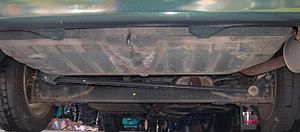Difference between revisions of "Beam axle"
m |
m |
||
| Line 1: | Line 1: | ||
| − | + | {{X}} | |
[[Image:Solid_Axle.jpg|right|thumb|300px|[[Solid axle]] and [[Panhard rod]] on a 2002 [[Mazda MPV]]]] | [[Image:Solid_Axle.jpg|right|thumb|300px|[[Solid axle]] and [[Panhard rod]] on a 2002 [[Mazda MPV]]]] | ||
| + | |||
| + | |||
A '''beam axle''' is a [[suspension (vehicle)|suspension]] system, also called a '''solid axle''', in which one set of wheels is connected laterally by a single beam or shaft. A [[live axle]] is a type of beam axle in which the shaft (or shafts, since live axles, while connected to move as a single unit, are seldom one piece) also transmits power to the wheels; a beam axle that does not also transmit power is sometimes called a '''dead axle'''. Beam axles are commonly used at the rear wheels of a vehicle. | A '''beam axle''' is a [[suspension (vehicle)|suspension]] system, also called a '''solid axle''', in which one set of wheels is connected laterally by a single beam or shaft. A [[live axle]] is a type of beam axle in which the shaft (or shafts, since live axles, while connected to move as a single unit, are seldom one piece) also transmits power to the wheels; a beam axle that does not also transmit power is sometimes called a '''dead axle'''. Beam axles are commonly used at the rear wheels of a vehicle. | ||
Latest revision as of 00:25, 8 August 2009
A beam axle is a suspension system, also called a solid axle, in which one set of wheels is connected laterally by a single beam or shaft. A live axle is a type of beam axle in which the shaft (or shafts, since live axles, while connected to move as a single unit, are seldom one piece) also transmits power to the wheels; a beam axle that does not also transmit power is sometimes called a dead axle. Beam axles are commonly used at the rear wheels of a vehicle.
Beam axles are typically suspended either by leaf springs or coil springs. In some cases, a Panhard rod or similar device may be used to control the lateral motion of the axle.
A similar suspension is the Twist-beam rear suspension, in which the beam axle also functions as an anti-roll bar to control the roll motion of the body.
The principal advantage of the beam axle is that it is simple and cheap to manufacture. It also engages little or no interior volume within the vehicle. Its drawbacks are that it does not allow each wheel to move independently in response to bumps, and the mass of the beam is part of the unsprung weight of the vehicle, which can further reduce ride quality.
Beam axles have an important advantage for off road applications, as it provides better vehicle articulation. They are also generally stronger and less prone to failure in a high load environement, such as for off-roading.

Beam axles are nonetheless common on low-cost, front-wheel drive cars, particularly minivans and other vehicles placing a great emphasis on maximum internal volume.
